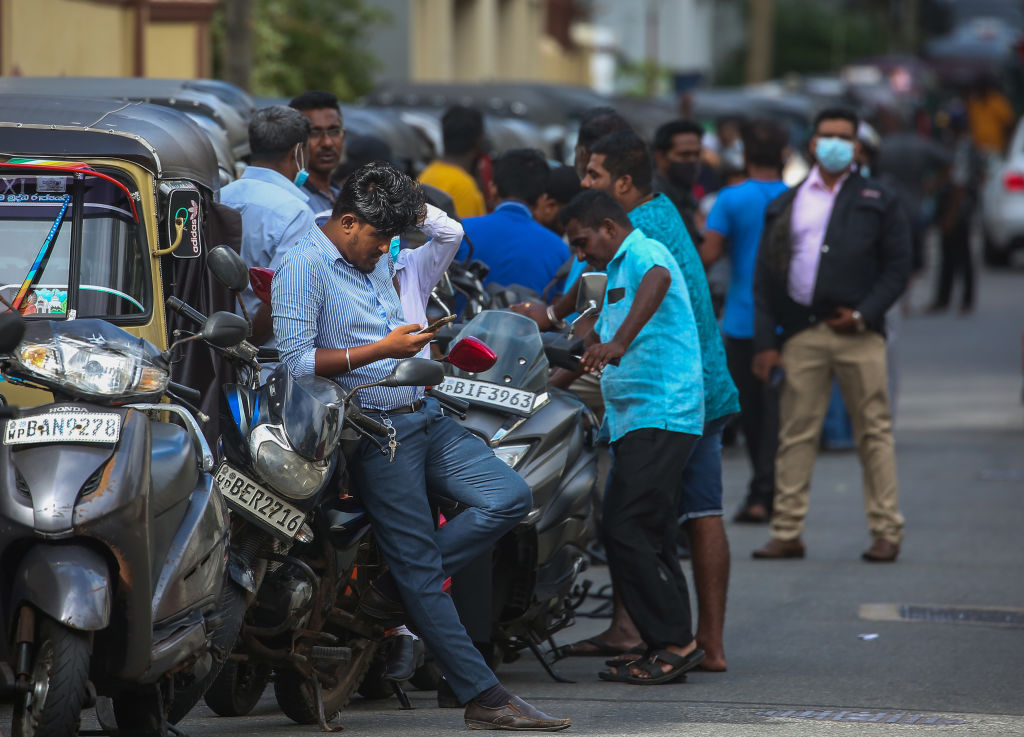
Sri Lanka’s impending default on $12.6 billion of overseas bonds is flashing a warning sign to investors in other developing nations that surging inflation is set to take a painful toll.
The South Asian nation is set to blow through the grace period on $78 million of payments Wednesday, marking its first sovereign debt default since it gained independence from Britain in 1948. Its bonds already trade deep in distressed territory, with holders bracing for losses approaching 60 cents on the dollar. The government said last month it would halt payments on foreign debt.
Sri Lanka’s situation is unique in the way all debt crises are—the particulars here involve an unpopular government run by an all-powerful family, the unresolved aftermath of a 30-year civil war and violent street protests. But the island’s saga is starting to be seen as a bellwether for emerging markets where shortages exacerbated by inflation, including record-high food costs globally, have the potential to roil national economies.
“The Sri Lanka default is an ominous sign for emerging markets,” said Guido Chamorro, the co-head of emerging-market hard-currency debt at Pictet Asset Management, which holds Sri Lankan bonds. “We expect the good times to stop. Slowing growth and more difficult funding conditions will increase default risk particularly for frontier countries.”
Sri Lanka, an $81 billion economy located off India’s southern coast, has been mired in turmoil for weeks amid annual inflation running at 30%, a plummeting currency and an economic crisis that has left the country short of the hard currency it needs to import food and fuel. Anger over the situation—brought about by years of excessive borrowing to fund bloated state companies and generous social benefits—has boiled over into violent protests.
Widespread arson and clashes were reported from several parts of the country while homes and properties of several government lawmakers were set on fire. At least nine people, including one member of parliament, were killed in the violence.
Sri Lanka is currently without a finance minister, which could complicate efforts to get through the crisis as the government struggles to restore security and get a bailout from the International Monetary Fund. At the same time, it needs to negotiate a restructuring with creditors including BlackRock Inc. and Ashmore Group.
The nation’s dollar bonds are among the worst performers in the world this year, with only Ukraine, Belarus and El Salvador’s Bitcoin-busted notes faring worse. The government on April 18 failed to transfer about $78 million in coupons to holders of debt maturing in 2023 and 2028, leading S&P Global Ratings to declare a selective default. Fitch Ratings and Moody’s Investors Service have yet to declare official defaults, despite issuing their own warnings.
After the grace period on those payments ends Wednesday, negotiations with creditors can begin in earnest, a process that will be key to winning aid from the IMF. The country has previously said it needs between $3 billion and $4 billion this year to pull itself out of crisis.
The nation’s $1 billion dollar debt due this July was indicated 0.24 cents higher at 42.73 cents on Wednesday, near the record low of 42.5 cents reached last week, according to data compiled by Bloomberg.
But getting such a deal done quickly won’t be easy. While President Gotabaya Rajapaksa has already called on one of his political opponents to take over as prime minister after the resignation of his brother, Mahinda Rajapaksa, instability lingers. Divides remain deep after a 30-year civil war that ended in 2009, and the central bank governor has threatened to quit if political stability doesn’t return soon.
“We are in a fluid situation that is very perilous for Sri Lanka,” said Matthew Vogel, London-based portfolio manager and head of sovereign research at FIM Partners.
Risk of Replication
As Sri Lanka struggles with the turmoil, its problems provide a warning for other emerging markets where heavy debt loads are converging with economic issues and social unease. The challenge is made more difficult as the Federal Reserve and other major central banks raise interest rates in a bid to quell inflation, leading to higher borrowing costs.
“They are now forced to face their debt burdens amid tightening financial conditions,” said Trang Nguyen, executive director of emerging markets strategy at JPMorgan Chase & Co.
At least 14 developing economies tracked in a Bloomberg gauge have debt yields at an excess of 1,000 basis points over US Treasuries, a threshold for bonds to be considered distressed.
The added pressures of rising food and energy prices has already started to bubble up in other countries, including Egypt, Tunisia and Peru. It risks turning into a broader debt debacle and yet another threat to the world economy’s fragile recovery from the pandemic. Pakistan, Ethiopia and Ghana are also in danger of following suit, Bloomberg Economics said last month.
“Sri Lanka could be the start of a trend across the frontier and emerging markets where governments experience debt crises — and possibly default on their obligations,” said Brendan McKenna, a strategist at Wells Fargo in New York who says Pakistan and Egypt look particularly vulnerable. “As rates move higher, a lot of the fundamentally weaker countries with dollar-denominated debt may struggle to repay bonds.”
— With assistance from Ronojoy Mazumdar, Lilian Karunungan and Liau Y-Sing.
More Must-Reads From TIME
- The 100 Most Influential People of 2024
- Coco Gauff Is Playing for Herself Now
- Scenes From Pro-Palestinian Encampments Across U.S. Universities
- 6 Compliments That Land Every Time
- If You're Dating Right Now , You're Brave: Column
- The AI That Could Heal a Divided Internet
- Fallout Is a Brilliant Model for the Future of Video Game Adaptations
- Want Weekly Recs on What to Watch, Read, and More? Sign Up for Worth Your Time
Contact us at letters@time.com